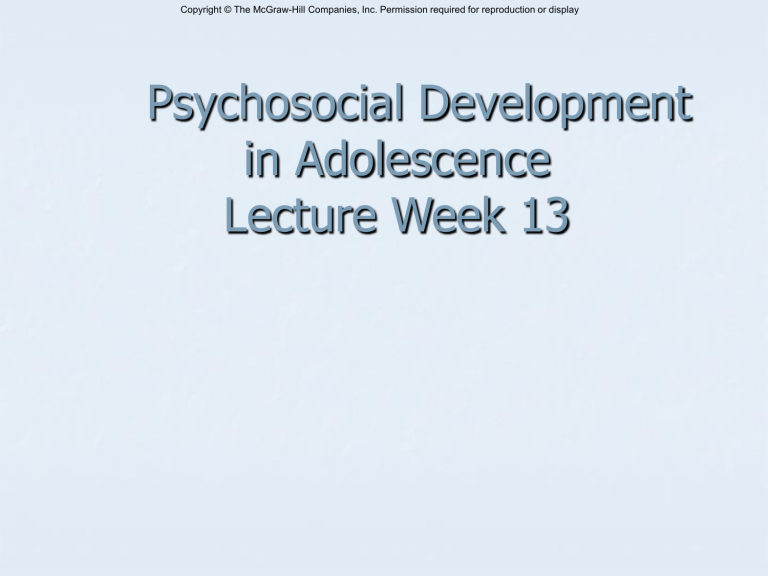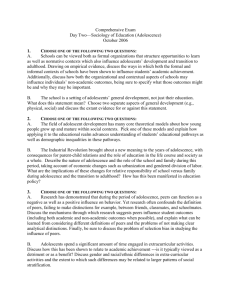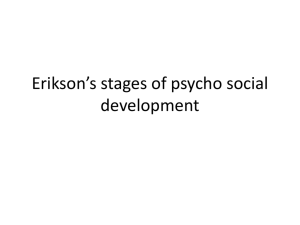Psychosocial Development In Adolescence

Copyright
© The McGraw-Hill Companies, Inc. Permission required for reproduction or display
Psychosocial Development in Adolescence
Lecture Week 13
Overview
Relationships with Family, Peers, and Adult
Society
Is Adolescent Rebellion a Myth?
How Adolescents Spend Their Time
Adolescents and Parents
Adolescents and Siblings
Peer and Friends
Anti-social Behaviour and Delinquency
Adolescence
Adolescents spend more time with ______ and less with ______________
Fundamental values remain close to their parents’
Adolescents turn to peers for companionship and ____________ and to parents for a secure base from which they can try their wings (roots and wings)
Is Adolescent Rebellion A Myth?
G. Stanley ______ believed that young people ’ s efforts to adjust to their changing bodies and demands of adulthood usher in a period of “ storm and ______________ ”
Full-fledged rebellion appears to be ___________, at least among middle-class youngsters who are in school (1:5 experience rebellion)
Although adolescents may defy parental authority with some regularity, it does not normally lead to major family conflict or a sharp break with parental or societal standards
Most young people feel _________ to and _______ about their parents, share opinions on major issues, and value their parents’ approval
Changing Time Use and Changing
Relationships
As youngsters move through adolescence, much of this time is spent talking and
“ hanging out ” with peers, and increasingly with peers of the
___________ sex
Family
The character of family interactions changes:
Less time watching television together but more one on one __________________
Mothers appear to be more approachable than fathers for adolescents
_______ of grade 10 students feel their parents understand them (more boys than girls)
Family Conflict
Parents want their children to be _______________ but find it difficult to let go
Family conflict is often over “how much” or “how soon” and concern day to day matters
Most frequent during early adolescence (strains of
________________) but most intense during middle adolescence (____________ strains around independence)
Hinges on adolescents’ personality (hot temper, meanness, anxiety) and parents’ treatment of them
Parenting Styles
Most adolescents’ ______________ when they feel they come from a loving home with responsive parents
____________________ parenting seems to work best because they insist on important rules, norms, and values but are willing to listen, explain, & negotiate
Teens whose parents were strict in enforcing behavioral rules had fewer behavioral problems than those with more _____________ parents
What kinds of issues caused the most conflict in your family when you were a teenager, and how were they resolved?
If you had lived with both parents, were your conflicts more with one parent than with the other? Did your mother and father handle such issues similarly or differently?
Adolescents and Siblings
Adolescents are less __________ to siblings than to either parents or friends, are less influenced by them, and become even more _____________ as they move through adolescence
Adolescents still show intimacy, ________, and admiration for their brothers and sisters
Younger siblings still tend to look up to older ones
Peers And Friends
The peer group is:
a source of emotional support during a complex transition as well as a source of
________________ for behaviour a source of affection, sympathy, understanding, and __________ guidance a place for experimentation a setting for achieving autonomy and independence from parents a place to form ____________ relationships
Antisocial Behavior And Juvenile
Delinquency
What influences young people to engage in – or refrain from - violence?
What determines whether or not a juvenile will grow up to be a hardened criminal?
An Epidemic of Youth Violence
(Box 17-2)
______________________
Refuse to listen to ______________ figures
Ignore feelings of others
Mistreat people
Rely on violence to solve problems
Believe life has treated them _____________
Look ______________ than peers
Cut classes (held back, suspended, drop out)
Use alcohol, drugs, join gangs, fight, steal, or
_____________ property
Video: Bowling for Columbine
Those Prone to Violence
Female perpetrators of violence
____________________ opinions of themselves
Life experience in which women were ___________ and violence was considered justified
Overly permissive or ____________ home atmosphere
Negative self-image prevents them from successfully succeeding at school or other constructive interests
_____________ or fearless, low IQ’s, learning disabilities
Witnessed or have been victims of ________________
Heavy exposure to media violence (desenstizing viewers to violence and depicting situations in which aggression is rewarded or justified)
Prevention
Signs that the epidemic of youth violence is
_________________
Successful preventive programs have given parents help in reducing the stress of child rearing and training in ________________ skills
Give young people substantial responsibility and opportunities to participate in making rules
Suggestions for parents; _______ and monitor television viewing, encourage participation in sports and other supervised after-school activities, use non-physical methods of discipline, teaching young people to stand up against _________________
Is There a ‘Universal Adolescent’?
Offer Self Image
Questionnaire
(5,938 adolescents in 10 countries)
1.
2.
Five aspects to self
Psychological self
___________l self
3.
4.
5.
Sexual self
Familial self
____________ self
Results
Cross-cultural commonalities particularly familial, social, and _____________
______ out of 10 had positive feelings toward parents, valued work, and friendship, and tried to learn from _______________
Described themselves as _______, able to cope with life, make decisions, and enjoyed a job well done, were confident in their sexuality, did not harbour grudges against parents, saw their mother and fathers as getting along most of the time, expected to be able to take ___________






